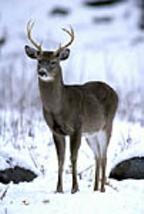

Common Names: Virginia
white-tailed deer, Key deer, jumping deer
Genus: Odocoileus
Species: virginianus

The fur of the white-tailed deer is a grayish color in the winter then more red comes out during the summer. It has a band of white fur behind its nose, in circles around the eyes, and inside the ears. More white fur goes down the throat, on the upper insides of the legs and under the tail.
Only the males have antlers, which they shed in January to March, and grow out again in April or May. The white-tailed deer can be 3 to 3 1/2 feet at the shoulders. Males can weigh up to 400 pounds, and females from 70 to 200 pounds.
It is mostly active at night but they can be active at any time. They will feed mostly just before dawn for several hours and again from late afternoon untildusk. They graze on green plants in the summer and nuts and acorns during the winter. They will also eat twigs and the buds of birch, maple and conifer trees in the winter.
After mating, which lasts from October to December, the doe will give birth about 7 months later to one or two fawns. The fawns are spotted with white, which they lose by their first winter. Fawns can walk at birth and nibble on grasses a few days later. They are usually weaned by six weeks. White-tailed deer live to be about 10 years, but some have lived as long as 20 years in captivity.
The white-tailed deer is usually a solitary animal, but females and fawns will band together at times. During mating season a buck may join these groups and try to keep other bucks away. During the winter white-tailed deer will form herds to keep warm.
The white-tailed deer has protective coloring, or camouflage, that allows it to hide in the undergrowth. If you were walking by and it was standing nearby, you probably would have to look hard to see it . When they are disturbed they make a snorting sound and stamp their hooves to alert other deer to danger. When they run away they will raise their tail, which will stick up like a white flag. This alerts other deer to danger and gives the fawns something to follow. They have very good eyesight and hearing, but depend mainly on their sense of smell to detect danger.
The white-tailed deer lives in farmlands, brushy and forested areas in most of southern Canada and except for two or three states in the west, all of the mainland United States. They also range throughout Central America to Bolivia.
The white-tailed deer was once nearly wiped out in much of the northeast and midwest of the United States, but because of hunting restrictions and fewer predators, there are now more than ever.
2000
Bibliography:
Deer and Elk Publisher, Clarin Books, 1967
photo credit: Harold Wilions, http://home.earthlink.net/~h111/index.html